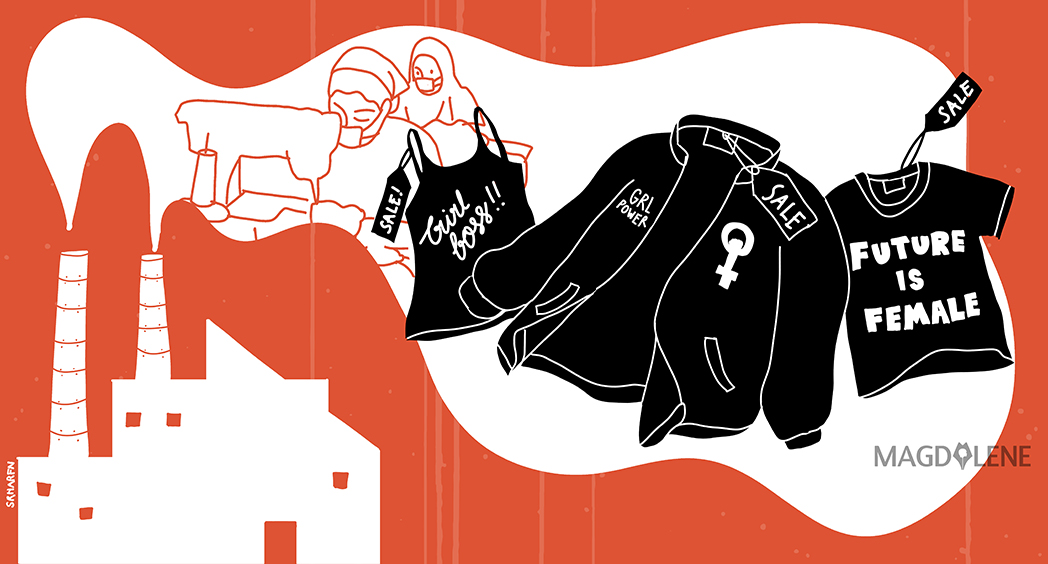We’ve all seen it, one way or another.
It’s Women’s March week, and all retail stores suddenly had the chicest clothes with the catchiest catchphrase about some variation of Feminist Ideas put on full front at their display mannequins: “Boss Lady”, “The Future is Female”, “Girl CEO”, or “smash the patriarchy”. Other products ranging from pillowcases to snacks now displayed some ominous positive encouragement to their women consumers on their tin, making them feel visible and cared for by the companies that they buy from.
Lately, it seems that all corporations had collectively became vaguely woke. Their most recent advertisement displayed general gender equality ideations and accommodated it to simultaneously sell their products.
One of Nike’s “Just Do It” ad displayed Serena Williams full-front being her badass self while wearing her Nike outfit ensemble. Dove’s billboards now chanted “Real Beauty” while displaying unedited, un-airbrushed, regular-looking women of all ages. L’Oréal had a literal eyeshadow palette titled Feminist on sale. Hollywood had their movies tailored to fit more badass-looking actresses into their screens, all who could out-sass everyone and discover time machine and lead the revolution in their free time.
There’s a name for this phenomenon; it’s called femvertising.
When feminism was catapulted into the mainstream through media exposure, two things started to happen; one, they started to gain millions of masses worldwide, most of them women, and; two, the movement started the crackdown of the century, calling out outdated practices of sexism and systematic gender discrimination that norms, people, government, and companies had allowed to happen within their watch for thousands of years.
Feminism was not only a new movement meant to liberate women who are systematically oppressed and disadvantaged due to their genders, it created quite a clear-cut distinction on what behavior was acceptable and what was not on personal and professional grounds. And in the age of technology, widespread distribution of information, and higher education rates, it is no surprise that many women these days support feminism, or at least some form of women empowerment.
With the gaining popularity of the movement, many corporations needed to integrate its elements within their business plans. And make no mistake, it is indeed a necessity; with half the world’s population and the majority of most corporation’s customers being women, these companies need to be on women’s good sides and not be seen as part of the system designed to dehumanize and dismantle their worth and personhood.
Enter femvertising, which were not only designed to not do Just That™, but extensively to lure women to buy their product in a false sense of allegiance. “We hear your cries of injustice,” said the ads, the product designs, the twitter accounts to their customers. “We’re here to support your cause.” “We’re in the same team.” It’s a system that both painted them to be the good guys and catapulted their sales to the latest social trend. It’s practically a win-win solution for the Companies that use this strategy.
As a customer, though, bear in mind that femvertising does not necessarily erase the already existing red ledger on these Companies’ belts. In fact, most times femvertising were used as a systemic cover-up using jargons and catchy designs for the inequalities they had and continue to commit.
While Zara and Gap were mass-producing t-Shirts screaming “You Owe Me 21 Dollars” (referencing the 21 percent wage gap between men and women working on the same field), their parent company Inditex was perpetuating mass exploitation of their labor workers which consisted of mostly women, putting them through inhumane work hours with no health insurance coverage and payrolls way below the minimum wage.
Only 2 weeks after L’Oréal announced their UK “True Match” campaign which focused on gender inclusivity, they dropped their transgender model Munroe Bergdorf for an out-of-context quote regarding her take on systemic racism and white supremacy.
In-between their constant use of femvertising to promote their products, Dolce & Gabbana still managed to launch sneakers that promotes body dysmorphia (the fact that “I’m thin & gorgeous” is written on the shoes’ sides were seen as tone-deaf, especially contextualized with Stefano Gabbana’s fat-shaming comments on twitter in respond of the backlash). And don’t forget, they once released a promotional ad that implicitly romanticizes and glamorizes gang-rape with a seemingly helpless woman pinned down to the ground, surrounded by naked men all looking down on her (the image was banned in Italia and Spain after the controversy blew up).
Ignoring or excusing these behaviors in favor of their femvertised products would hurt both the credibility and the impact of the women empowerment movements itself on the long run. By continuing to feed into their business strategies without conducting proper research on whether or not they are truly morally ethical and in line with gender equality ideas, we are contributing to the trivialization of the movement.
For outsiders and non-supporters, it would seem that rather than a genuine and systematic social change, women empowerment would be just yet another vain trend on the market with seemingly aimless, if not unfaithful goals. This would put a damper on the effort made by the movement, resulting in the discredit of gender equality ideas by the masses, especially by the sceptic and the misogynists. In extreme cases, women empowerment would lose its credibility and lose its momentum, fading into the background and unable to finish making meaningful changes across the globe.
With the rise of conservativism and far-right government, it is important for supporters and members of progressive movements to calculate their steps, not only in spreading messages and doing their conducts, but also on building images of association that would be deemed profitable for the movement’s cause.
While we cannot put a cap on femvertising, we can at least start to learn how to be an ethical consumer, seeing beyond the ads and product designs displayed on the sale racks, and actually searching on how the companies reflect the movement they want to profit from. As a supporter of gender equality and female empowerment, this is the least we can do.
Illustration by Adhitya Pattisahusiwa







Comments